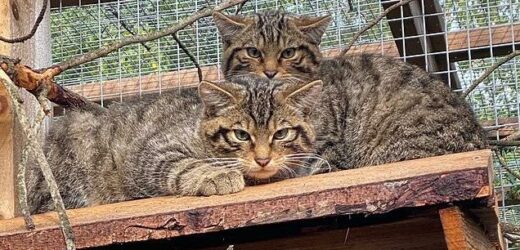The return of the ‘Highland Tiger’: 22 wildcat kittens are born at wildlife park – and could be the first of the species released into the wild in Britain in 200 YEARS as part of bid to save them from extinction
- Scotland’s last wildcat group is no longer deemed a viable population
- Scientists paired 16 wildcats up in captivity in the hopes they would breed
- Twenty-two kittens have been born between April and August
- The animals could be released into the wild as early as 2023
Twenty-two wildcat kittens have been born in the Highlands – and could be among the first of the species released into the wild in Britain in 200 years.
The wildcats, nicknamed ‘Highland Tigers’, have been bred as part of a conservation project led by the Royal Zoological Society of Scotland (RZSS).
The Saving Wildcats project is working with national and international experts to restore Scotland’s critically endangered wildcat population by breeding and releasing them into carefully selected locations in the Cairngorms National Park.
Planning is under way to release the kittens, which were born between April and August this year, into the Highlands in 2023.
Twenty-two wildcat kittens have been born in the Highlands – and could be among the first of the species released into the wild in Britain in 200 years
Scotland’s wildcats
The wildcat was hunted and persecuted to extinction in England and Wales more than a century ago when all predators were considered vermin.
It has not been able to return since, due to loss and fragmentation of habitat and more recently interbreeding with domestic and feral cats.
Scotland’s last wildcat group is no longer deemed a viable population.
But it is hoped restoring a healthy number of one of the few native predators could restore balance in the ecosystem.
They perform important functions like controlling prey such as rabbits and rodents while giving other hunters competition for food.
David Barclay, Saving Wildcats conservation manager, said: ‘These kittens are the future of wildcats in Scotland with decades of extensive research showing their species is highly likely to go extinct in Britain if we do not carry out releases.
‘Our target for the first breeding season was 20 kittens, so to have 22 in just six litters is a huge success which gives us a great base for the next phase of the project.
‘While human presence is kept to a minimum to give these cats the best possible chance of survival after release, our small team of expert keepers are able to monitor the kittens and their parents on remote cameras.
‘It has been fantastic to watch them grow and develop over the summer.
‘Once the kittens are fully independent and no longer reliant on their mums, they will move into special pre-release enclosures which are designed to help prepare them for the many challenges of life in the wild.’
Planned releases of wildcats in Scotland are subject to a translocation licence.
The Saving Wildcats project is based in a quiet area away from visitors at RZSS Highland Wildlife Park near Kingussie.
It is led by RZSS in collaboration with NatureScot, Forestry and Land Scotland, the Cairngorms National Park Authority, Norden’s Ark, and environment authorities in Andalucia, Spain.
Dr David Hetherington, nature networks manager at the Cairngorms National Park Authority, said: ‘The Cairngorms National Park is home to over 25 per cent of the UK’s rare and endangered species and it is incredibly exciting to be working with national and international partners to plan wildcat releases here.
‘Scotland’s wildcats have been identified as a priority species in our five-year Cairngorms Nature Action Plan and this successful first breeding season at the Saving Wildcats centre is a significant milestone in our collective efforts to save this critically endangered species from extinction in Britain.’
The wildcat was hunted and persecuted to extinction in England and Wales more than a century ago when all predators were considered vermin.
It has not been able to return since, due to loss and fragmentation of habitat and more recently interbreeding with domestic and feral cats.
Scotland’s last wildcat group is no longer deemed a viable population.
But it is hoped restoring a healthy number of one of the few native predators could restore balance in the ecosystem.
They perform important functions like controlling prey such as rabbits and rodents while giving other hunters competition for food.
MOST SUCCESSFUL BREEDING YEAR FOR RARE HEN HARRIERS IN THE PEAK DISTRICT FOR MORE THAN A DECADE
The National Trust has had its most successful breeding year for rare hen harriers in the Peak District for more than a decade.
The charity said seven youngsters have successfully fledged from multiple nests on National Trust land in the High Peak. This follows work with the RPSB and Peak District Raptor Group to encourage birds of prey to live in the national park.
The trust said it had undertaken work including cutting heather to encourage a more diverse range of moorland plants including sphagnum moss, bilberry and cottongrass, helping support wildlife such as small mammals that the birds rely on for food.
The trust is also working with its tenants to ensure they manage the land to support more birds of prey in the area.
Hen harriers are England’s most threatened bird of prey, due to historic persecution and because they prey on red grouse chicks to feed their young, bringing them into conflict with commercial shooting estates.
They have seen numbers increase from a low in 2013 where no birds successfully fledged from nests in England, leaving the bird on the brink of extinction in the country.
Source: Read Full Article




